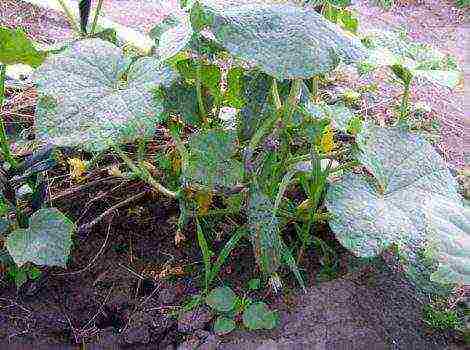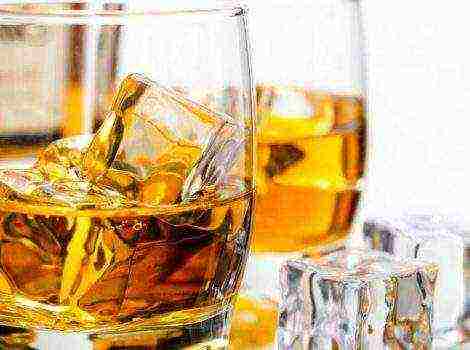Content
- 1 ‘Altai early 166’
- 2 ‘April F1’
- 3 ‘Herman F1’
- 4 ‘Muromsky 36’
- 5 ‘Moscow dude F1’
- 6 ‘Zozulya’
- 7 'Cascade'
- 8 ‘Finger’
- 9 'Borovichok F1'
- 10 ‘Bush’
- 11 'Competitor'
- 12 'Sphinx'
- 13 ‘Advance F1’
- 14 'Red mullet F1'
- 15 ‘Benefit F1’
- 16 'Goosebump F1'
- 17 ‘Orlik F1’
- 18 ‘Valdai F1’
- 19 ‘May F1’
- 20 'Spring F1'
- 21 'Nightingale F1'
- 22 'Pickling F1'
- 23 ‘Semcross F1’
- 24 'Fair F1'
- 25 ‘Gypsy F1’
- 26 Varietal variety of cucumbers
- 27 The most popular varieties with names
- 28 Early harvest methods
- 29 Using greenhouses
- 30 How to choose the right variety
Cucumbers
undoubtedly not only one of the most popular but also one of the earliest cultures. You can get the first harvest of fragrant cucumbers as early as 37-45 days after
sowing
... Soon after the emergence of seedlings, young plants enter the phase of active flowering, after which very little time passes (about 12-14 days), and instead of flowers, the first green plants begin to form. How to navigate the abundance of different cucumber varieties and really pick the earliest ones?

How to choose the right varieties of cucumbers and what you should pay attention to, we discussed in the article
Choosing varieties of cucumbers
... And we also talked about
15 best cucumber varieties for the middle lane
and about
unusual cucumbers and their exotic relatives
... And before we find out which varieties of cucumbers are the earliest, let's repeat an unbreakable and very important rule: whichever varieties you prefer - early, middle or late ripening - choose
only those that are suitable for growing in your area , which means that they are maximally adapted to the climatic conditions of the region. Only in this case (of course, with proper care) you will get the maximum yield of cucumbers that are not afraid
diseases
and practically will not suffer from adverse weather conditions.
‘Altai early 166’
The ‘Altayskiy early 166’ variety is one of the earliest and most productive varieties. It was zoned back in 1958, but it is still one of the most popular varieties among summer residents. Begins to bear fruit about 37-39 days after germination. It is quite resistant to fungal diseases and is cold-resistant. Light green white-thorn fruits of a fusiform shape are completely covered with small tubercles. In length, they reach 9-10 cm, and the mass of zelents reaches 80 g.
‘April F1’
Parthenocarpic (that is, self-fertile, not requiring pollination) hybrid 'April F1' - early, cold-resistant, with a predominantly female type of flowering. Begins to bear fruit on the 45-55 day. Designed for indoor cultivation; successfully grown on balconies and as an indoor crop. Zelentsy are cylindrical, dark green, large-lumpy, reaching 20-25 cm in length, with a mass of about 200-250 g.
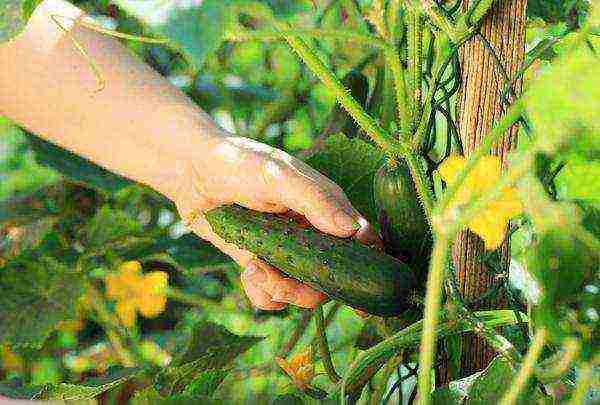
In addition to the fact that the greens of this hybrid are not prone to yellowing, they have a good taste, and the plants themselves have complex resistance to most diseases. Due to the fact that the formation of lateral shoots in plants is limited, the need for pinching and pinching, even periodic, is completely eliminated. From 1 m² you can get 8-13 kg of greens.
‘Herman F1’
Self-pollinated (parthenocarpic), over-yielding hybrid 'German', the first fruits of which appear already 40-43 days after germination, is intended for cultivation in greenhouses and open ground. Fruits - medium hillock green gherkins, about 8-10 cm long, are devoid of bitterness.The hybrid is characterized by a long fruiting period, as well as resistance to cucumber mosaic virus, powdery mildew and cladosporium disease.
‘Muromsky 36’
Zoned in 1943, 'Muromsky 36' is one of the earliest ripening early varieties: its growing season is only 32-45 days. Small tuberous light green fruits reach 7-10 cm in length, can be ovoid or ellipsoid. The growing season lasts about 4 weeks, and from 1 m² you can get about 3-4 kg of cucumbers. Despite a lot of advantages, the fruits of the Muromsky 36 variety have one significant drawback, which must be taken into account when growing it: the fruits begin to turn yellow very quickly, so they will have to be harvested quite often.
Cucumber Muromsky 36 "Successful seeds" Cucumber Muromsky 36 "Successful seeds"12 rblWATCH
OBI
Cucumber "April F1" (Aelita), double shelf life 0.25g16 rblWATCH
The Gardener's Empire
Cucumber Zozulya F118 rblWATCH
Sedek
Cucumber Herman F140 rblWATCH
‘Moscow dude F1’
The early maturing bee-pollinated 'Moscow dude F1' begins to bear fruit 40-45 days after germination. A hybrid of a predominantly female flowering type, intended for cultivation in greenhouses and open field. Plants of the variety are vigorous, with an average ability to form shoots.

The fruit is green, with white stripes, white-thorny tuberous greens with a diameter of about 3.5-4 cm, weighing about 100 g, reaching 10-12 cm in length. The hybrid is extremely resistant to bacteriosis and olive spot, with proper care it can be collected from 1 m² about 12-15 kg of fruit.
‘Zozulya’
The early ripening variety of cucumbers 'Zozulya' was released in 1977. Its vegetation period does not exceed 48 days from the moment the first shoots appear. The variety is high-yielding: about 20 kg of zelents can be obtained from 1 m² of area. Slightly lumpy white-thorned elongated fruits of a cylindrical variety, reach 18-22 cm in length, and reach 250 and even 300 g in weight. Plants are resistant to yellowing, have immunity to olive spot, as well as some other infectious diseases.
'Cascade'
The early ripening variety of cucumbers 'Cascade', the growing season of which lasts about 6 weeks, was zoned in 1982. Its fruits are very dense crispy greens with a lumpy surface, about 4 cm in diameter and 13-16 cm long. does not exceed 150 g. The variety is extremely picky about soil moisture, and lack of water affects the fruits: they acquire an irregular shape.
‘Finger’
Bee-pollinated universal variety. From emergence to the beginning of fruiting, it takes about 43-45 days. Designed for open field cultivation. Plants with a predominantly female flowering type, strongly plaited and medium-branched.
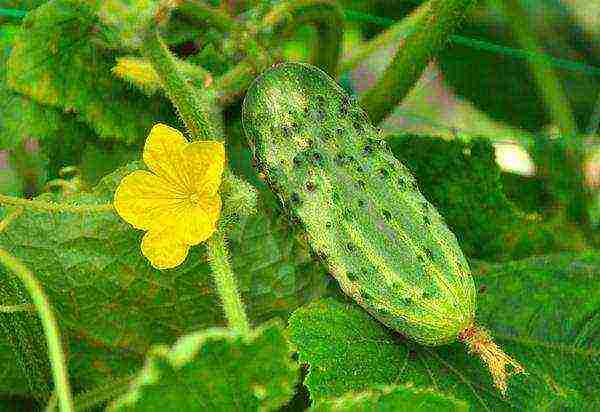
Fruits are dark green, elongated-cylindrical in shape, the surface is covered with sparse large tubercles. In length, zelents can reach 10-14 cm, and weigh up to 120 g. The variety is resistant to downy mildew and is distinguished by an extended fruiting period - up to 2 months.
'Borovichok F1'
'Borovichok F1' is an early ripening bee-pollinated hybrid of cucumbers, from germination to the beginning of fruiting which takes about 43-48 days. Predominantly female flowering type; intended for cultivation in greenhouses, open ground; prone to the formation of parthenocarpic (self-fertile, not requiring pollination) fruits. Zelenets reaches 10-12 cm long, and weighs 80-100 g. The fruit itself is without bitterness, green with white stripes, lumpy, covered with small black thorns. The hybrid is resistant to root rot, as well as true and downy mildew. From one plant, you can get up to 6 kg of greens.
Bush cucumber13 rblWATCH
Russian Vegetable Garden
Cucumber Finger12 rblWATCH
Russian Vegetable Garden
Cucumber Competitor15 rblWATCH
Sedek
‘Bush’
The early ripening variety of cucumbers 'Kustovoy' with a predominantly female type of flowering is intended for growing under temporary film shelters and in the open field. The dark green fruit of the variety is an ovoid-elongated green plant weighing about 70-90 g, reaching 10-12 cm in length. The plant is weakly branching and quite compact. From 1 m² you can get about 10-12 kg of fruit.
'Competitor'
The early ripening 'Competitor' variety, zoned in 1980, fell in love with our summer residents for its yield, resistance to bacterial spotting and powdery mildew, which has plagued many gardeners in the past few years. Fruits of the ‘Competitor’ variety are large-lumpy, oval-cylindrical in shape, reaching 12 cm in length, and up to 100 grams in weight. The variety is used exclusively for cultivation in the open field and bears fruit better on a trellis than just in a garden bed. Its growing season lasts about 1.5 months.
'Sphinx'
Early ripening: fruits ripen about 39-40 days after germination.
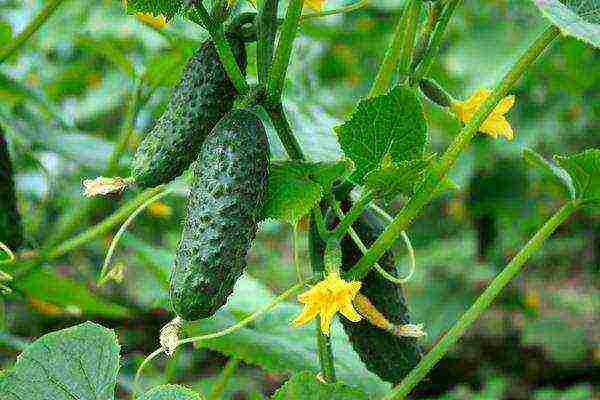
Fruits of an oval-elongated shape are evenly colored dark green. The surface of the fruit is ribbed, completely covered with small tubercles. The yield of the variety is about 5 kg of greens from 1 m².
‘Advance F1’
An early ripening hybrid, the growing season of which is 39-44 days. Parthenocarpic, with a female flowering type; can be grown both outdoors and in greenhouses and greenhouses. Plants are medium-branchy (by the way, this variety is valued precisely for the limited growth of lateral shoots) and vigorous, therefore, they need to build a support. Fruits are cylindrical, often lumpy, dark green in color; about 3-4 cm in diameter, 11-13 cm long, and weighing up to 120-130 g. The hybrid is extremely resistant to root rot, real and downy mildew, olive spot. The yield of the variety is about 12-14 kg per 1 m².
'Red mullet F1'
Parthenocarpic hybrid with predominantly female flowering type. After the emergence of seedlings, it begins to bear fruit on the 43-48 day. Designed for cultivation both in protected and in the open field. Fruits - greens, reaching 10-12 cm in length, with a mass of 95-100 g; often tuberous, white-spiked, dark green. The hybrid is relatively resistant to real and downy mildew, and from 1 m² you can get up to 7 kg of greens.
‘Benefit F1’
An early ripening hybrid, the growing season of which (from germination to fruiting) is 43-50 days. Parthenocarpic, female flowering type; can be equally successfully cultivated both in the open and in the protected ground, and from 1 m² about 6-8 kg of cucumbers are obtained. Fruits - dark green white-thorn greens, genetically devoid of bitterness, completely covered with small tubercles; length - 10-13 cm, weight - about 100-120 g. The hybrid is very resistant to root rot, as well as to downy and powdery mildew.
'Goosebump F1'
An early ripening parthenocarpic hybrid of the female type of flowering, bred by the agricultural firm "Gavrish" (you can learn more about this and many other seed producers from our review).
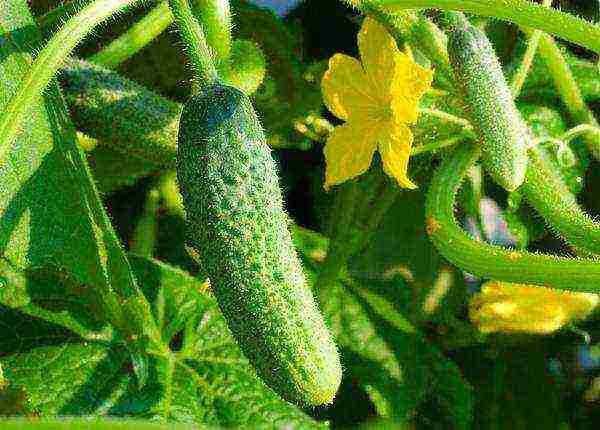
From emergence to the beginning of fruiting, 42-45 days pass. Small black-spiked fruits with large wide tubercles reach 8-12 cm in length. Productivity from 1 m² is about 7 kg. You can read more about this variety in our article 15 Best Cucumber Varieties for the Middle Strip.
‘Orlik F1’
An early ripening parthenocarpic hybrid of the female type of flowering, from the emergence of seedlings to the beginning of fruiting which takes about 47-50 days. Designed for growing in greenhouses. The fruit is a white-thorny lumpy green plant weighing 120-150 g, reaching 14-16 cm in length, genetically devoid of bitterness. The hybrid is relatively resistant to root rot and downy mildew, and is also resistant to powdery mildew.
‘Valdai F1’
The bee-pollinated, predominantly female flowering type is a hybrid intended for cultivation in greenhouses and open field. From the emergence of seedlings of the variety to the beginning of fruiting, it takes about 48-50 days. The plants are vigorous, with an average ability to form shoots, very resistant to unfavorable growing conditions. Small dark green, with white stripes, cylindrical green greens in length reaches 10-12 cm, weighing about 100 g. The variety was specially created for processing. Relatively resistant to downy mildew and powdery mildew, to root rot.
‘May F1’
An early ripening hybrid that begins to bear fruit 46-48 days after germination. Bee-pollinated, intended for cultivation in open ground and greenhouses. The fruit is a white-thorny large-tuberous green plant about 15-20 cm long, the mass of which reaches 150-200 g. The hybrid is relatively resistant to powdery mildew, root rot. Differs in amicable fruiting: from 1 m² you can get about 30 kg of greens.
'Spring F1'
The fruiting period of this hybrid begins 40-48 days after germination. Bee-pollinated, with a predominantly female flowering type, it is intended for cultivation in greenhouses and open field.
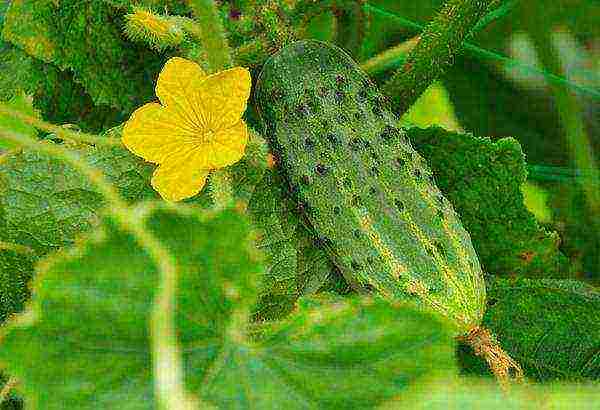
Green, with light stripes, a cylindrical shape of green, slightly elongated at the base, weighing up to 100-120 g. The slightly lumpy fruit reaches 9-10 cm in length.The hybrid is resistant to most cucumber diseases, including anthracnose, bacteriosis, downy mildew and olive spot. With proper care, about 25 kg of fruit can be obtained from 1 m².
'Nightingale F1'
Belonging to the best mid-early hybrids, 'Nightingale F1' begins to bear fruit 42-46 days after germination. The fruit is deep green, oval-cylindrical, all covered with large, sparsely located tubercles. The weight of the fruit is about 70-90 g, and the length of the zelents reaches 8-10 cm. Bee-pollinated, for cultivation in greenhouses and open ground. Plants are medium-sized, resistant to the main diseases of cucumbers.
Cucumber Orlik F1 Gavrish 10 pcs Cucumber Orlik F1 Gavrish 10 pcs19 rblWATCH
OBI
Cucumber May F117 rblWATCH
Agrofirm Search
Cucumber Nightingale F117 rblWATCH
Agrofirm Search
Cucumber "Valdai F1" (Gavrish), 10 pcs.13 rblWATCH
The Gardener's Empire - Gavrish
'Pickling F1'
An early maturing bee-pollinated hybrid, from the emergence of shoots to the beginning of fruiting of which 45-47 days pass. Designed for open field cultivation. Plants are long-leaved, medium-branched, medium-sized. Fruits are elongated-cylindrical large-tuberous greens, reaching 10-12 cm in length, with a mass of about 100-125 grams.
‘Semcross F1’
A bee-pollinated hybrid, the fruiting period of which occurs 40-43 days after germination. Designed for cultivation in greenhouses and open field. Plants are short-leaved. Fruits are dark green, with light stripes and large tubercles, elliptical greens, genetically devoid of bitterness, reaching 8-10 cm in length. The variety is comprehensively resistant to diseases.
'Fair F1'
An early ripening hybrid, begins to bear fruit about 43-48 days after germination. Bee-pollinated, with a predominantly female flowering type, intended for cultivation in greenhouses and open field. Bright green, with white stripes, cylindrical greens, slightly narrowed at the base, genetically devoid of bitterness. In length, the fruits reach 9-10 cm and weigh up to 100 g. The hybrid is relatively resistant to such diseases of cucumbers as downy mildew and powdery mildew, as well as root rot.
‘Gypsy F1’
From germination to the beginning of fruiting of this hybrid, 43-48 days pass. Intended for growing in open ground and greenhouses.Bee-pollinated, with a predominantly female type of flowering, vigorous, with an average ability to shoot. Black-thorny tuberous greenback is a short gherkin 9-11 cm long, and weighing 80-100 g. The hybrid is extremely resistant to real and downy mildew, root rot.
Of course, I have listed far from all the popular varieties of early cucumbers, which, thanks to the work of breeders, appear more and more every year. And it doesn't make much sense to list them all: each of you, dear summer residents, probably have your favorites. Please tell us in the comments about them which varieties of early cucumbers do you like the most and why? Or maybe some varieties disappointed you, and the descriptions of the varieties declared by the producers did not correspond to reality? Then share your experience. Let's discuss not only the most beloved varieties of early cucumbers that did not meet expectations - this is the only way we can save each other from mistakes. And good harvest to you!
For interesting and useful information on growing cucumbers and their seedlings, see here:
- 9 most productive cucumber hybrids
- Cucumber - the secrets of growing
- Growing cucumbers: planting, care, feeding, varieties
- Cucumbers: personal experience of growing, useful tips
- 11 secrets of a good harvest of cucumbers
- Most-very: the best hybrids of cucumbers from the agricultural firm "Gavrish"
- Choosing the right cucumber seeds - and everything will be a bunch
The success of the cucumber crop depends in particular on the choice of seed. The wide assortment on the shelves confuses thoughts rather than allows you to make the right decision. Novice gardeners are advised to first familiarize themselves with the varieties, their names, the characteristics of cultivation and care.
Depending on climatic conditions, different varieties can be planted in Ukraine, Belarus, Chernozem, Bashkiria and the middle lane - these can be parthenocarpic, early ripening, with a long ripening period, or delicious cucumbers for growing in a greenhouse. More information is structured in the article in the form of a kind of list-rating.
Varietal variety of cucumbers
A large number of varieties allows you to choose the best options that have disease and weather resistance the region where the green plant is planned to be grown.
A common mistake is the use of certain 2-3 varieties, the cultivation of which has been practiced for several decades.
Domestic and foreign breeders have developed many hybrids that have no less affordable agricultural technology and excellent taste than the once loved cucumbers.
Among the top tips for growing vegetables, experts point to the need to plant several varieties at once... This makes it possible to evaluate the yield of different species under the same ripening conditions, to get at least some yield during drought or prolonged rains.
Collect the necessary and useful information about the varietal variety, the characteristics of the characteristics of zelents can be found below.
The most popular varieties with names
For the convenience of perception and application of the text in practice, plants are divided into separate groups, united by a common feature.
The best self-pollinating for outdoor use
Self-pollinating cucumbers have a number of advantages, among which excellent immunity and resistance to an abundance of moisture are noted.
- Booth - ripening period is only 40 days. The length of the green plant reaches 9 cm. One bush yields up to 3.5 kg. The strong immunity of the plant resists various diseases (olive spot, mosaic, powdery mildew).
- Courage - harvesting of the Kurazh variety begins 40-47 days after the sprouts break through from the soil. The weight of one cucumber reaches 170-180 gr., Up to 10 zelents are formed on one shoot. The plant practically does not suffer from rot, powdery mildew.
- Connie - harvesting of fruits begins on the 50th day after sowing. The culture is universal both in the way of cultivation and in the use of cucumbers.The length of the greenery is 10 cm, the yield from 1 m2 is about 9 kg.
- Berendey - fruits (12-15 cm) ripen 42 days after the sprouts appear. One bush can be harvested up to 3.5 kg. Zelentsy have excellent characteristics and have a long shelf life.
- Gerda - fruits 10 cm long appear 1.5 months after sowing. 2.8-3 kg are removed from the bush. The plant is rarely affected by diseases; it is especially resistant to fungal infections.
The best early ripe cucumbers
Early ripening varieties have a feature that every gardener should be familiar with.
The ovaries of male flowers are the first to form, they must be removed, since they interfere with the development of the plant.
- April - from the moment of planting, the fruits of April ripen on the 50th day, reaching a length of 20-22 cm. The plant itself regulates the growth of shoots, so the need for cutting falls off. Productivity from 1 m2 on average 22 kg. Cucumbers do not overripe if they miss the assembly deadline. The culture is resistant to almost all diseases, with the exception of root rot.
- Hermann - sprouts at 39-41 days after sprouting. The length of Herman's greens reaches 10 cm, 23-26 kg are harvested from 1 m2. The hybrid is characterized by a long fruiting period, self-pollination and immunity to fungi.
- Orlik - begins to bear fruit on the 47-50 day after sowing. The length of the greenery reaches 14-16 cm, with a diameter of 3.5-4 cm. 6-8 kg are removed from the bush. The culture has a strong immune system, resists powdery mildew, root rot, olive spot and TMV.
- Valdai - the bush begins to bear fruit on the 45th day after the emergence of shoots. Flowers are formed predominantly by women, therefore pollination by bees is required. The length of the greenery is about 10-11 cm, up to 4.5 kg of the crop is removed from the bush. The hybrid was developed for preservation, but due to its delicate taste it is also used for salad.
Mid-season
Medium ripening varieties begin to bear fruit on the 45-55 day after sowing the grains into the soil. All plants of this group differ in the method of cultivation (greenhouse, soil), purpose (fresh or for salting) and the type of pollination.
- Competitor - characterized as a viable and disease-resistant plant. The length of the greenery reaches 9-12 cm with an average weight of 100 grams. Up to 3.8 kg of the crop is harvested from each m2. The variety has good immunity and is resistant to powdery mildew.
- Nezhinsky - a variety pollinated by bees, characterized by a powerful stem, medium-sized fruits (length 10-12 cm, weight 90 g) and high yield (8 kg per 1 m2). Nezhinsky tolerates low temperatures, is resistant to many diseases. Cucumbers have a high taste.
- Libella - a versatile hybrid with a long fruiting period. With proper care, you can harvest until the coldest months. The length of the Libelle greenery reaches 14 cm, weight - 140 grams. Up to 10-12 kg are removed from a square meter. When salted, the flesh remains crispy and firm. In agricultural technology, there are rarely cases of damage to crops by common diseases.
- Table - has an excellent taste without bitterness, ideal for salting. The bush is formed long with a strong whip, the length of the fruit reaches 12 cm and weighs 80-90 grams. Productivity from 1 m2 about 8 kg.
Late ripening
A feature of late-ripening cucumbers is that the seeds germinate well only in the 3rd year.
Therefore, the purchased material before planting is worth check for germination... Also, when choosing varieties of this group, you need to take into account the climate of the region and the ripening period of zelents in order to have time to collect most of the harvest before the onset of cold weather.
- Phoenix - the harvest period begins 64 days after seed germination. Cucumbers reach a length of 16 cm, with an average weight of 230 g. Phoenix bushes form a branched whip that resists the vagaries of the weather well.
- Winner - differs in long spreading lashes that easily tolerate drought, coolness.The plant is resistant to various types of fungi. Fruit length reaches 14 cm with an average weight of 110 grams. The yield from 1 m2 is 7-8 kg.
- Solar - the variety is mid-season, but most gardeners plant it as late. The bush releases many twigs, forming a massive whip, which implies planting in a large area. The peel of the greenery is covered with a few tubercles and greenish stripes. The length of a cucumber reaches 12 cm with an average weight of 140 grams.
- Brownie - the harvesting period begins 65 days after germination. The length of the cucumbers is small (9 cm), but the taste is high. The culture has good immunity, showing resistance to almost all common diseases. Productivity - 6-8 kg per 1 m2.
- Chinese - a disease-resistant variety with a mild taste and lack of bitterness. A feature of the fruit of the Chinese cucumber is considered to be a short shelf life after harvest. Original elongated cucumbers (30-35 cm) look like snakes. The plant tolerates low temperatures and poor lighting well.
Which are the highest yielding for greenhouses
All gardeners, without exception, are attracted by high-yielding varieties. In your greenhouse, you can try to grow the most popular of them.
- Parisian gherkin - fruits ripen in 50-60 days after sowing. The length of the Parisian gherkin variety reaches 12 cm with an average weight of 85 grams. A large number of ovaries are formed on the lash, which guarantees a high yield - over 30 kg per 1 m2. Low germination of seeds provides for planting beds through seedlings.
- Fontanelle - a popular cucumber among gardeners in our country. It is grown in almost every area. The dimensions of the Spring greens reach 22-24 cm with an average weight of 150 grams. More than 10 kg are removed from the bush. In terms of taste and rules of agricultural technology, the variety remains competitive in front of the best European developments of breeders.
- Zozulya - the harvesting period begins on the 45th day after sprouting. The formation of the lash is carried out in such a way that the bush does not need pruning. Zelentsy reaches 24 cm in length with an average weight of 280-300 grams. From a square meter, you can collect up to 30 kg of Zozulya cucumber. The plant practically does not get sick with olive spot and cucumber mosaic.
For planting outdoors
- Suzanne - a versatile crop that can be grown not only in the open field, but in a greenhouse and even on a balcony. The length of the lash reaches 3-4 m, forming a large number of ovaries. Plucking fruits 3-4 centimeters long or wait until they become larger, this does not affect the taste. Suzanne has good disease and pest resistance.
- Sparta - the hybrid is bee-pollinated with stable fruiting. The length of the greenery is 6-12 cm, the taste is pleasant without bitterness. The culture has a strong immunity, especially against powdery mildew and fungi. The yield per bush is 2.8-3.1 kg.
- Pickle - the fruiting period begins on the 55th day after the emergence of sprouts. The length of the green leaf is 9-11 cm with an average weight of 100-110 grams. More than 4 kg are removed from one bush. The pickle has a delicate taste with a sweetish note, without bitterness.
- Pinocchio Is a self-pollinated hybrid that begins to ripen 48 days after germination. The length of the greenery is about 8-9 cm with a weight of 85 grams. The yield per bush is 3.4 kg.
- Sturdy - by the rate of ripening, the cucumber is considered a sprinter, just 38 days after the emergence of sprouts. The length of the greenery is about 9 cm with a weight of 80 g. The fruiting period is fleeting, all ovaries form and ripen together. Unfavorable weather does not have a negative effect on the growing season.
For growing in Siberia
Growing cucumbers in a harsh climate has its own characteristics. It is better to plant cucumbers in Siberia in polycarbonate greenhouses or choose fruitful early maturing varieties.
When choosing seeds, preference should be given to varieties that are resistant to stress.
- Altaic - it has a short ripening period, the harvest begins 36-40 days after germination. The length of the greenery is 9-12 cm with a weight of 100 g. The plant is cold-resistant, easily tolerates the vagaries of the weather. After harvesting, the fruits retain their presentation and taste for a long time.
- Serpentine - gherkin type cucumber, ripens 39-42 days after germination. The fruiting period is intense, already in the first 10 days most of the harvest is harvested - over 1.7 kg per 1 m2. Serpentine is known for its taste, which lacks bitterness.
- Bush - a compact plant that needs pollination. The length of the greenery reaches 8 cm with a weight of 90 grams. Productivity is stable with proper care (3 kg per bush). The peculiarity of the variety is its endurance and strong immunity. Cucumbers are versatile.
Each variety of cucumbers has a range of impressive benefits. The main thing when choosing is to take into account the climatic features of the region and the correspondence to them of the characteristics of the varieties you like. Then the main stage of laying the future harvest will be performed correctly.

cucumber April F1
Using my many years of experience in growing cucumbers in a greenhouse and open field, as well as having studied the reviews of other gardeners on the forums and numerous neighbors in the garden, I can confidently advise you to plant the best varieties and hybrids of cucumbers. They are suitable for growing both in greenhouses and under temporary film shelters and in the open field. Each gardener chooses what suits him best.
Of course, for a greenhouse, it is better to take hybrid varieties of F1 cucumbers, since they have short side lashes and do not need to be pinched. Hybrids tend to have high yields and disease resistance.
If you choose varieties of cucumbers for the Urals and Siberia, then consider varieties and hybrids that bear fruit well in low light conditions and are cold-resistant.
If you plant cucumbers in a greenhouse or greenhouse that require pollination by bees, do not forget that from the beginning of flowering, bees should have free access to flowers.
Cucumber varieties with photos and descriptions, reviews
Cucumbers Herman F1
An early, high-yielding parthenocarpic hybrid with a long fruiting period. The plant is powerful, with sufficient nutrition it simultaneously forms up to 6-7 fruits in one node. Fruits are green, dense, large tuberous, gherkin type, genetically without bitterness.
The hybrid is resistant to cladosporia, powdery mildew and cucumber mosaic virus. It is grown both in greenhouses and in the open field in vertical and horizontal ways.
Productivity of cucumbers Herman: up to 9 kg per plant per season (subject to timely watering and feeding).
Cucumbers Masha F1
The earliest (37-39 days before fruiting), parthenocarpic hybrid. The fruits are standard in size, 8-11 cm long, ripen together, have a very attractive appearance. They are good both fresh and salted.
The hybrid is resistant to cucumber mosaic virus, cladosporiosis, powdery mildew, relatively resistant to downy mildew.
Productivity of cucumbers Masha: more than 10 kg of fruits per 1 sq. meter of landings.
One of my favorite cucumbers.
Cucumbers Connie F1
An early high-yielding parthenocarpic (not requiring pollination) hybrid of the gherkin type, 43-45 days pass from germination to the beginning of fruiting. The plant is medium-growing, with a bundle formation of ovaries.
Cucumbers are short, cylindrical, 7-9 cm long and weighing 60-80 grams, bright green, small-tuberous, white-thorn. Crispy, juicy, without bitterness, with excellent taste. The hybrid is resistant to overgrowth, powdery mildew and root rot.
Connie F1 is a multipurpose cucumber used for fresh consumption and for processing. Recommended for growing in open and protected ground.
Connie's cucumber yield: 14 - 16 kg / m².
Cucumbers Courage F1
Early ripening parthenocarpic hybrid (from germination to fruiting 45-50 days), female flowering type, intended for cultivation in greenhouses.
The plant is vigorous, with medium shoots. In the nodes, 2-4 ovaries are formed (often up to 5-6 ovaries).
Fruits are dark green with light stripes, 12-15 cm long, weighing 120-130 grams, lumpy, white-thorn, universal use. Taste quality is high, without bitterness. Planting density 2.5-3.0 plants per sq. meter. The hybrid is relatively resistant to the main diseases of the cucumber.
Cucumber yield Courage: 6-8 kg / plant.
Cucumbers Nezhinsky 12
One of the best pickling varieties. It is grown in open ground and in film shelters. The variety is mid-season, bee-pollinated, unpretentious, disease-resistant. Long-leaved bush.
Cucumbers are short, elongated-ovoid, large-tuberous, black-spiky, 10-12 cm long, weighing 80-110 grams. The flesh of the fruit is crispy and has excellent taste. The variety is resistant to olive spot and bacteriosis.
Productivity of cucumbers variety Nezhinsky 12: 1.5 - 2 kg / sq. m.
Agricultural technology: at the end of May, seeds are planted in greenhouses and in the ground, or 20-25 day old seedlings. Planting density - 3 plants per 1 sq. M. The seeding depth is 1.5-2 cm. The soil should be fertile with high aeration (sawdust, leaves can be added).
Cucumbers Miranda F1
Early maturing, high-yielding, versatile hybrid, with a well-pronounced parthenocarp of a predominantly female flowering type. These cucumbers are intended for cultivation in foil greenhouses and open field. The plant is vigorous, well leafy, in a node from one to two ovaries.
Cucumbers 11-12 cm long, weighing 110-120 g, cylindrical in shape with white thorns, green color with white dots throughout the greenery and stripes up to the middle of the fruit. The fruits are juicy, aromatic, good both in salads and for any processing, especially in salting.
Hybrid advantages: has increased cold resistance and group resistance to diseases, including powdery mildew, early maturity.
Productivity of Miranda cucumbers: up to 6.3 kg / sq. m.
Sowing: seeds or 25-35 day old seedlings are planted in unheated greenhouses or in the ground at the end of May, when the soil warms up to 14-15 ° С. Planting density: when grown in spread - 3-4 plants / 1 m², vertical production on stakes / trellises - 2-3 plants / 1 m². The seeding depth is 1.5-2 cm.
Cucumbers Ira F1
An ultra-early maturing bee-pollinated hybrid of a predominantly female flowering type, from germination to the beginning of fruiting 45-50 days. The plant is medium-growing, in one node there are 2-3 ovaries.
Cucumbers are cylindrical, 12-15 cm long, weighing 55-85 grams, dark green, large tuberous, with white pubescence. The pulp is dense, crispy, with excellent taste. The hybrid is characterized by high stable yields and complex disease resistance. Designed for outdoor cultivation.
Cucumber yield Ira F1: 9.5 - 10.2 kg / m 2.
Agrotechnics: Cucumbers are grown through seedlings or by sowing seeds in the ground. Seeds are sown under a film to a depth of 2-3 cm, seedlings are planted at the age of 20-25 days, when the threat of frost has passed and the soil warms up to 10-12 C. Planting scheme is 3-5 plants per 1 sq. m. The culture is demanding on heat, moisture and soil fertility. Care consists in regular watering with warm water. Once every 10 days, watering is combined with top dressing (1 liter of slurry or 10 grams of urea per 1 liter of water). The plant is formed by pinching over the third leaf.
Cucumbers Karelian F1
Self-pollinated high-yielding short-fruited hybrid. It begins to bear fruit on the 43-45 day from the moment of germination. Cucumbers 8-10 cm long, fusiform, large tuberous. Fruits of high taste and marketability. Salting.
Hybrid advantages: cold resistance, extended fruiting period, intensive simultaneous filling of several ovaries. The hybrid is not sensitive to temperature changes.It bears fruit well on poor soils. Well suited for growing in the Urals and Siberia.
Cucumber yield Karelian: 14.8 kg / sq.m.
Agrotechnics: planting density in plastic greenhouses 3 plants per 1 m². The hybrid reacts positively to pollination or spraying with a boric acid solution (1 g per 1 l of water) at the very beginning of fruiting. In film greenhouses, side shoots are pinched over 2-3 leaves. Plants are not formed under temporary film shelters and in open ground.
Care: regular watering with warm water. Once every 10 days, watering is combined with top dressing (1 liter of manure or 10 g of urea per 1 liter of water).
Cucumbers Emerald Stream F1, description
An early ripe parthenocarpic hybrid for growing in open ground and film shelters. The period from germination to the beginning of fruiting is 44-48 days. The plant is vigorous, weakly plaited, mainly with a female flowering type.
Cucumbers are elongated-cylindrical, lumpy, dark green, with a delicate thin skin, 30-50 cm long, weighing 150-200 grams. They have excellent taste and aroma.
Cucumber Productivity Emerald Stream: up to 6 kg / sq. m.
The value of the Emerald Stream hybrid is in resistance to powdery mildew, cold resistance, shade tolerance, long and continuous fruiting period. Perfect for salads.
Cucumbers variety Delicacy
An early ripe variety of cucumbers for growing in the open field. The plant is powerful, with long lashes.
Cucumbers are cylindrical, leveled, small-lumpy, 9-12 cm long. The skin is soft, dark green. The flesh of the fruit is firm, high in sugars. The seed chamber is small. All these qualities indicate that Delicatessen is the most suitable variety of cucumbers for canning and pickling for open ground.
Advantages of the variety: resistance to short-term cold snaps, extended period of fruiting.
The yield of cucumbers of the Delicacy variety: up to 7 kg from 1 sq. meter of landings.
Agricultural technology: seeds or 20-25 day old seedlings are planted in unheated greenhouses and in the ground at the end of May. Planting density 3-4 plants per 1 m². The seeding depth is 1.5-2 cm. The soil should be fertile with high aeration (add sawdust, leaves).
Cucumbers Corinna F1
An ultra-early ripening, high-yielding parthenocarpic hybrid of German-bred cucumbers for open and protected ground with a friendly yield. The plant is medium-sized.
Cucumbers (improvement of F1 Horses in shape and color) - gherkins, 8-10 cm long, dark green, small tubercles, white thorns, genetically without bitterness, excellent consistency. They remain firm and crispy in salting and canning. The hybrid is resistant to a number of diseases.
Corinne cucumber yield: 5.2 - 6 kg of fruits per 1 sq. meter of landings.
Agrotechnics: in greenhouses and in the ground, seeds or 20-25 day old seedlings are planted at the end of May with a planting density of 3 plants per 1 m² and a seeding depth of 1.5 cm.
Care: regular watering with warm water. Once every 10 days, watering is combined with top dressing (1 liter of manure or 10 grams of urea per 10 liters of water). The plant is formed by pinching over the Z-leaf.
Gherkin Madame F1
Early maturing (43-48 days) bee-pollinated hybrid for growing in open ground and in a greenhouse. The plants are vigorous, mainly with a female type of flowering and a bundle arrangement of ovaries (3-6 per node).
Cucumbers are short, cylindrical, often and small tuberous, dark green with small white stripes, white-spiked, with a thin delicate skin, up to 10-12 cm long, weighing 65-85 grams, dense, do not outgrow or turn yellow.
Cucumber yield Madame F1: 10.5 - 14.0 kg / m².
Hybrid value: resistance to downy mildew and root rot, intense fruit formation and friendly yield, no bitterness. Zelens of this variety are recommended for fresh consumption, canning, cooking of lightly salted cucumbers.
The plant is formed by pinching over a 3-leaf.
Cucumbers of the Graceful variety
Early maturing (40-50 days), bee-pollinated variety, for open ground, medium-growing. It is resistant to olive stain and has high cold resistance.
Zelentsy are small tuberous, white-spiked, 10-13 cm long, weighing about 140 grams.
The yield of cucumbers of the Graceful variety: 5 - 7 kg / sq. m.
It is recommended to plant this variety according to the scheme: 50 x 50 cm.
Cucumber variety Graceful is perfect not only for fresh consumption, but also for pickling and pickling.
Cucumbers Alligator F1
Early maturing (46-48 days) bee-pollinated hybrid, with long fruiting, for spring film greenhouses and open ground. The plant is powerful, vigorous.
Cucumbers are elongated-cylindrical, green, lumpy, shiny, with a thin delicate skin, 35-40 cm long, sweet, juicy, fragrant.
Cucumber yield Alligator: 14 - 16 kg / m².
Hybrid value: resistance to downy mildew and powdery mildew, long fruiting period, excellent taste. Recommended for fresh consumption and canning in sliced wedges.
Cucumber Chinese disease-resistant F1
Hybrids of the "Chinese Sustainable" series are distinguished by high productivity, endurance and excellent quality. Mid-early (48-54 days) hybrid for growing in open (on trellises) and protected ground. The plant is vigorous, with short internodes and small leaves, forms into a single stem.
Cucumbers are smooth, cylindrical, dark green, with a shiny large-tuberous surface, smooth at the base, "with a handle", 30-35 cm long. Taste qualities are high.
Productivity of cucumber varieties Chinese disease-resistant high.
Hybrid value: high resistance to disease, hardiness to cold and low light. Recommended for salads, canning and pickling in sliced wedges.
Gherkin Son F1 Regiment
Mid-early (40-45 days) bee-pollinated hybrid of cucumbers for open ground and film shelters. The plant is medium-sized, medium-branched, mainly of the female flowering type.
Cucumbers are oval, rarely and with large tubercles, green with short stripes, white thorns, 6-8 cm long, do not outgrow or turn yellow.
Cucumber yield son of the regiment: 3.6 - 4.5 kg / m 2.
Hybrid value: resistance to downy mildew, cucumber mosaic virus, scab of pumpkin crops, abundant and long-term fruiting, high taste, technological and commercial qualities, suitability for collecting and processing gherkins and pickles (2-4 cm). The appointment is universal.
Cucumbers variety Pickled
Early maturing (41-46 days) bee-pollinated variety for open ground. The plant is long-leaved, medium-sized, medium-branched, of a mixed type of flowering.
Cucumbers are elongated-cylindrical, large tuberous, green with light stripes of medium length, with black pubescence, 10-11 cm long, weighing 100-125 grams.
Cucumber yield Pickling: 3.5 - 5 kg / sq. m.
Variety value in resistance to downy mildew, stable yield, presentation and high salting qualities. The variety is recommended for pickling.
Cucumbers Director F1
Early maturing (from germination to the beginning of fruiting 43-45 days), parthenocarpic hybrid. The plant is vigorous with a well-developed root system. In one node, 2-3 fruits are formed.
Fruits are cylindrical, large tuberous, dark green, white-thorn, 9-10 cm long, 3-3.5 cm in diameter, weighing 65-80 grams, genetically without bitterness. The top of the fruit is green, does not turn yellow from the first to the last harvest. Taste and commercial qualities are excellent. Also, this hybrid is characterized by high shade tolerance and a long fruiting period.
The hybrid is resistant to cucumber mosaic virus, powdery mildew, cucumber vessel yellowing virus, and downy mildew. Cucumber Director is recommended for cultivation in greenhouses: in the first turn - 3-3.5 plants / m2 and, especially, in the second turn - 2.5-3 plants / m2, as well as in the open field. It is used for both fresh consumption and canning.
Cucumber Productivity Director: in the greenhouse 18-20 kg / m2, in the open field 12-14 kg / m2.
We recommend purchasing cucumber seeds from the Sady Rossii online store.
What varieties of cucumbers do you grow? Which ones are the most productive? And the most delicious, without bitterness? What varieties of cucumbers would you recommend for the Moscow region, Siberia, the northwest?
Your feedback on the varieties of cucumbers will help many gardeners choose the best varieties and hybrids for planting. Attach a photo if possible.
Cucumber is a thermophilic plant, and no matter how strong your desire to get fruits as early as possible, you have to put up with the fact that you cannot get a good harvest without adhering to certain planting dates. The only thing that can help you in this case is the use of seeds that allow you to get early maturing cucumbers.
Early harvest methods
There are two ways to get early cucumbers:
- preliminary planting of seedlings;
- sowing in greenhouses earlier than usual.
The first option is practiced, as a rule, by experienced summer residents, who enjoy such events, since caring for any seedlings, including cucumber, requires discipline and attentiveness on the part of the owner. In addition, you must have enough space to be able to set up the seedling boxes in close proximity to natural light sources.

But even if all these conditions are met, cucumbers grown in this way very rarely meet the stated expectations. The fact is that plants, for a long time being in conditions different from real ones, after planting in greenhouses or on open beds, are unable to withstand the influence of various natural factors. Some shoots, for example, can be burned by the sun's rays and simply burn out, others will be unprepared for the natural temperature of the soil, and even if the soil is properly prepared for them, the shoots will not cope with low temperatures.
In practice, you can find only a few dozen varieties of cucumbers for each region, which would be adapted for growing through seedlings. But even they shouldn't be counted on.
A second, more efficient way for early ripening of cucumbers is to plant seeds directly in the greenhouse.
Using greenhouses
Due to the fact that cucumber seedlings immediately fall into real living conditions, they do not need to get used to the sun's rays again, the shoots are very strong and strong. However, this option has its own subtleties.
For early ripening of cucumbers, sowing should be carried out in a timely manner - in the second half of April.
At this time, in many regions, the soil, at best, only has time to thaw, naturally, it makes no sense to plant seeds of early varieties of cucumbers in cold soil. Therefore, it is necessary to prepare in advance both the greenhouse and the seed.
Increasing cold resistance of plants
It is possible to make the shoot more resistant to cold weather, which is the main reason for failed early harvests, even at the stage of preliminary preparation of the seed. For this, a hardening procedure is used. Its essence boils down to the fact that seeds that have not yet sprouted are wrapped in a damp cloth and placed in conditions with an ambient air temperature of about 0С (the best option for this would be a refrigerator). After 48 hours, the seeds are taken out and sown immediately.
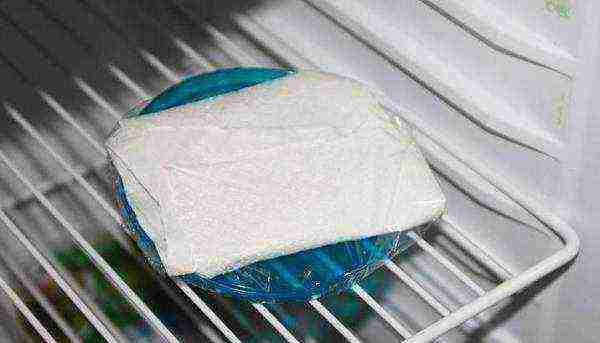
When hardening cucumber seeds, you must carefully follow the instructions. If you put them in the refrigerator after they hatch, you will lose seeds; if the temperature is below 0С, the result is the same.
Another effective way to protect early ripening cucumbers is the formation of steam (warm) ridges in the garden. Thanks to a specially prepared surface for planting, the root system of the seedlings will always be warm, this is due to the decomposition of the biological mass involved in creating the beds.Since the root system of a cucumber plant is the most sensitive part of it, by protecting the roots from the cold, most likely it will be possible to preserve all the seedlings.
Greenhouse preliminary preparation
Ultra-early varieties of cucumbers require early preparation of greenhouses. It is recommended to start the process in the fall. First of all, it is necessary to rid the space of the old soil completely. This must be done without fail if the outgoing season has not been without fungal or bacterial infections attached to the crops planted here. And it doesn't matter what kind of culture they were. If they hurt, then the soil should be completely replaced. In the event that the sores have passed your garden, you can do with removing only the top layer of soil. It is possible, but still undesirable.
The vacated spaces must be filled with organic residues. These can be: leaves of trees and shrubs, tops, straw, turf grass, etc.
Since it is straw that produces the greatest amount of heat during decomposition, it is desirable that more than half of the total volume of organic matter.
In early spring, the surface prepared in this way is covered with a 15-20 cm layer of snow, which, a couple of weeks after application, is covered with a black film in two layers. When sunny days come, the soil under the film will actively warm up, the snow will begin to melt and saturate the soil with moisture.
After a week or two, when the thawing process is completed, organic fertilizers, or rather manure, must be introduced into the greenhouse. The manure is mixed with sawdust and organic matter, as well as with a layer of new soil and the remains of the old. After the completion of the process, all this is covered with a film for another week until it warms up completely.
How to choose the right variety
All varieties of cucumber seeds on the market can be grouped according to three main characteristics: by the rate of fruit ripening, by the method of pollination and by the method of cultivation.
By the time required for ripening:
- ultra early ripening varieties with a growing season of up to 40 days;
- early cucumbers with a ripening period of up to 45 days;
- mid-ripening varieties, the first fruits of which can be obtained in 45-50 days;
- late cucumbers with a vegetative period exceeding 50 days.
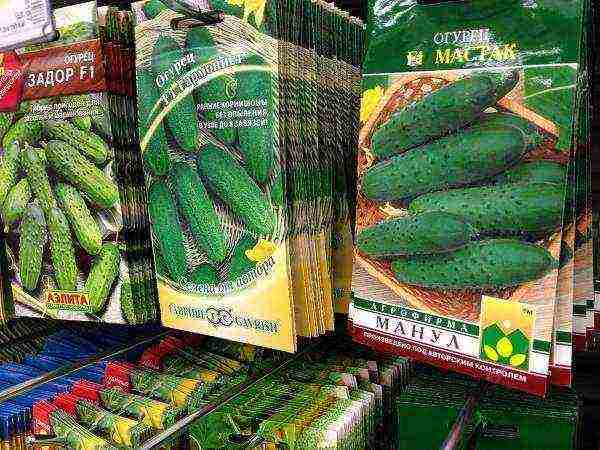
By pollination method:
- bee-pollinated;
- self-pollinated;
- parthenocarpic.
With the first option, everything seems to be clear. Such varieties of cucumbers require the presence of bees participating in the fertilization procedure, and therefore it is better to use them in greenhouses or in open beds, where bees fly regularly.
Parthenocarpic and self-pollinated cucumbers do not need bees. They differ from each other in that the former form ovaries without the presence of the very fact of pollination, while the latter contain both a stamen and a pistil in each flower, which allows them to pollinate themselves on their own.
By cultivation method:
- for planting in greenhouses and in open spaces;
- for sowing in greenhouses.
This classification is very arbitrary, since there are enough varieties from which you can equally successfully get crops both on the street and in closed spaces.
For open ground
So, the following are the best early varieties of cucumbers for open ground:
- "Goosebump". Parthenocarpic variety, the name of which very well describes the appearance of the fruit - large bumps on the surface resemble numerous goosebumps. The fruits themselves are short, regular cylindrical in shape, have a very pleasant smell. Cucumbers appear in 43-45 days, each plant can be harvested up to 8 kg of fruit per season.
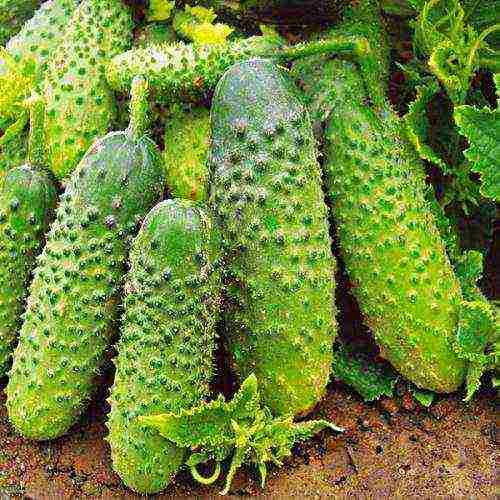
- Bathory. Refers to productive parthenocarpic hybrids, allowing to get more than 10 kg of fruits from each plant. Ideal for growing cucumbers, which will require processing in the future - salting, preservation, etc. Refers to medium-sized variants with a bundle type of ovary formation. The fruits themselves are small, up to 10 cm long, tasty and sweet.

- "Aquarius". A bee-pollinated variety that allows for early harvests. Cucumbers are larger than those of most varieties (up to 14 cm in length), oval, elongated, without a tendency to yellowness. It stands out from the total mass by a long fruiting period - subject to the rules of planting and care, it completes the period of ovary formation 2-2.5 weeks later than other early soil varieties. The yield of "Aquarius", however, is not too happy - only 2.5-3 kg of cucumbers per bush per season.
- "Diva". Delicious bee-pollinated hybrid, the fruits of which are ideal for use in fresh salads. It belongs to the varieties of cucumber plants that ripen early and at the same time give a decent level of yield (up to 10 kg per square meter), cucumbers 15-20 cm long are distinguished by a smooth surface, while they have an excellent aroma and a sweetish aftertaste.
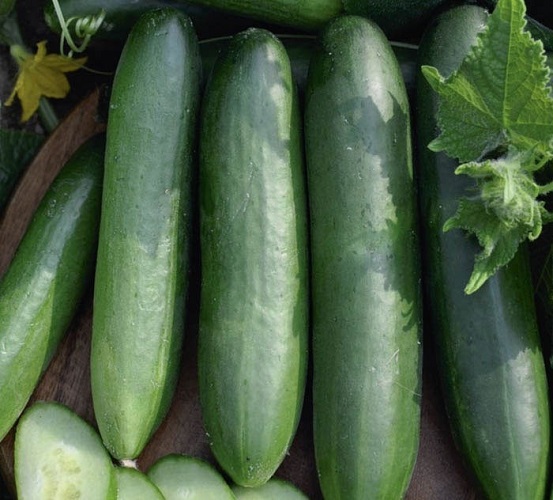
“I have been growing cucumbers for a long time, and I fell in love with the Diva variety for various reasons. Firstly, it gives very decent yields, and consistently, every year. Secondly, cucumbers of this variety are among the first to hit the table. And, finally, their taste is simply excellent. With each new season, I plant more and more bushes of this variety. I recommend everyone to try it. "
Marina, 64 years old, Volgograd. - "Parade". Another variety of early open field cucumbers. The type of ovary formation is single, but high yield does not suffer from this. The type of flowering is mixed, the path of pollination is bees. Refers to ultra-early options with a ripening period of 35 days. Fruits with characteristic tuberosity, medium in size, especially good if eaten fresh. If conservation is planned, then greens collected at a young age, when they are still small, are suitable for this.
In a separate group, I would like to collect varieties of early cucumbers for open ground, characterized by a high rate of generation of the first fruits:
- "Baby". Ultra-early bee-pollinated variety. It is quite possible to get the first fruits in 35 days. Amazing palatability and versatility allow this variety to look equally good both fresh and raw. Cucumbers are small (up to 10 cm in length), with large tubercles, they are perfectly stored in the refrigerator for up to 2 weeks, without turning yellow and without losing their taste characteristics.
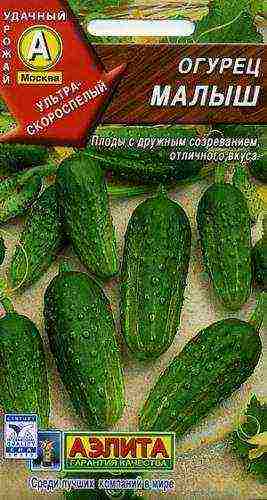
- Ajax F1. Excellent early cucumbers for open ground with a bundle type of ovary formation. Zelentsy are beautiful, 11-12 cm long, perfect for picking pickles. A high-yielding hybrid capable of producing up to 10 kg per sq. meter subject to growing conditions and care rules. The variety is heat-resistant, immune to many cucumber diseases, and bears fruit abundantly throughout the season.
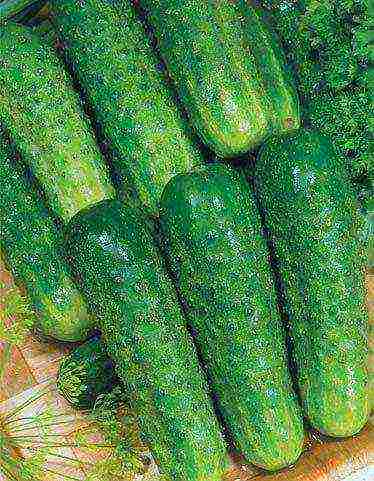
- "Herman F1". What are the most popular cucumbers in our country? Perhaps these are the ones. German possesses unique characteristics that contribute to obtaining high yields in the early stages. The hybrid is parthenocarpic, each bunch can form up to 9-10 ovaries. From one square. m, it is almost guaranteed to remove 9-10 kg of fruits, and if the growing conditions are favorable, then much more. The cucumbers themselves are beautiful, of the same size, tasty, without bitterness, even with inadequate watering.
The following names of varieties, as well as hybrids that are perfectly grown in open areas, can be attributed to the category of super early ripening:
- Levina F1;
- "Masha F1";
- Orpheus F1;
- "Son";
- "Khutorok";
- "April F1".
For greenhouse
Greenhouse conditions differ significantly from open spaces and require the culture to have special specific properties. One of the features of greenhouse cucumber varieties is the possibility of pollination without bees.
There is no place for bee-pollinated varieties in greenhouses, save them for open areas.
However, parthenocarpic hybrids should be diluted with pollinated varieties, since otherwise, with multiple flowers, ovaries will not be formed enough.
Let's go over the best varieties and hybrids of cucumbers for greenhouses:
- "Goosebump F1". Parthenocarpic hybrid produced by Gavrish. Refers to early ripening early cucumbers for greenhouses, although it can be successfully grown in open areas. The first fruits ripen on 42-45 days, the size of the fruits is 8-12 cm, with a black thorn, large-knobby surface. Possesses increased resistance to powdery mildew.
- "Boy with a finger F1". This hybrid was bred by the Manul company, in 2000 it was added to the state register of plants of the Russian Federation and is recommended for use throughout the country. The time required for ripening is 35-40 days from the date the first shoots appear. The name of the variety is extremely indicative - the cucumbers will be small, up to 11 cm in length and up to 60 g in weight, with white thornless thorns and abundant edging. It is not recommended to leave the fruits on the branches for longer than the prescribed period, as they are prone to overgrowing.
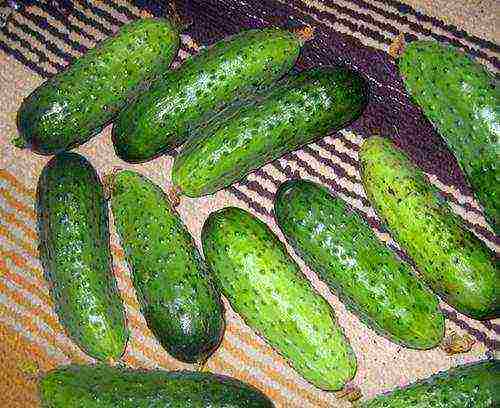
“I heard about this variety for a long time and now, finally, I decided to plant it on my site. What can I say? I didn’t regret it. I get fruits early, in sufficient quantities, caring for the bushes is the most common, I did not catch any diseases this season. The only nuance that I didn't really like is that you can't miss the moment of harvesting. I forgot to collect, left, and that's it - the cucumbers were gone. No, they didn’t rot, but they became big and tasteless. And the rest, if you do not allow such oversights, is a very good option. I recommend".
Mikhail, 52 years old, Moscow region. - "Benefit F1". Cucumbers ripen in 5 weeks. The hybrid does not require bees, forms fruits weighing up to 120 g, which are not bitter and have excellent taste. Perfect greenhouse cucumbers that will allow you not to worry about possible diseases, as they are completely tolerant of the most common options.
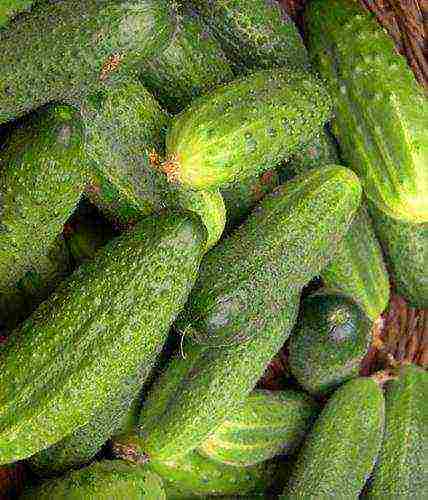
- "Alekseich F1". Another early cucumber variety that is great for greenhouse cultivation. The fruits ripen quickly and can be used for a wide variety of purposes. The hybrid is tolerant of powdery mildew and a number of other diseases, for these and many other reasons it has acquired a large number of fans.
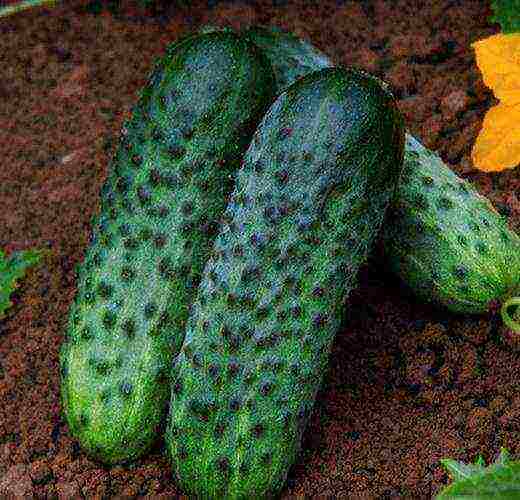
- Glafira and Emerald. Two more species not interested in bee pollination. Perfect for areas with a shortage of sunny and hot days, especially in this regard, the Glafira variety is good. "Emerald" is distinguished by increased productivity, this is a nuance that must be taken into account, these cucumbers do not tolerate too frequent plantings, that is, it is necessary to avoid thickening of the beds in every possible way. Otherwise, varieties that are very undemanding to care for - regular watering and periodic feeding will be quite enough to get the necessary yields.
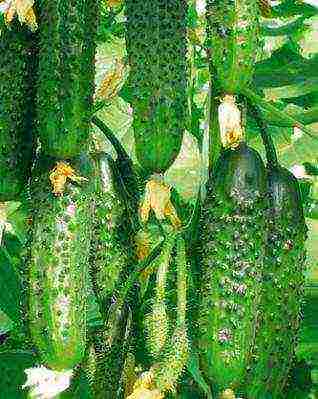
These and many other earliest varieties you can use in order to get a great harvest of cucumbers in the greenhouse or outdoors. Regardless of the region in which you live, there is always a way to grow this wonderful vegetable, the main thing is to show the necessary degree of discipline in observing the rules of care. In addition, the correct choice of varieties is also an important aspect. Not every culture is universal, there are varieties that can yield crops only in certain climatic conditions, which are difficult, and sometimes impossible to recreate artificially. There is no point in chasing cucumber varieties that require incredible efforts in the growing process. It is much more correct to choose the ones that will bring you pleasure from the care measures and will fully delight you with the results.

